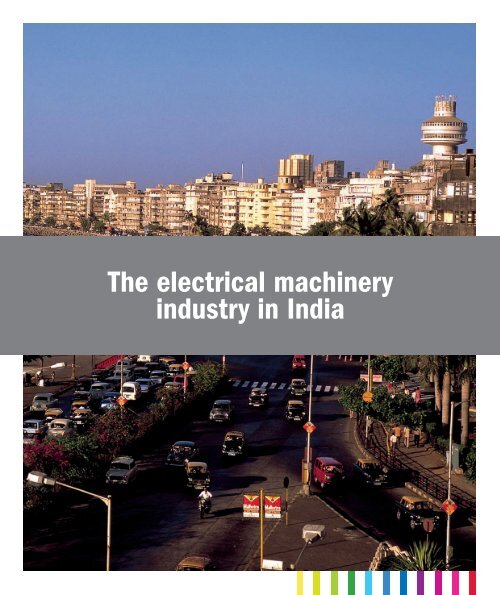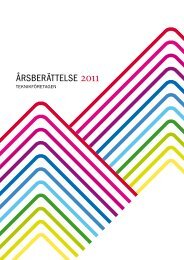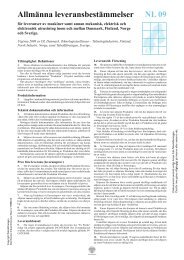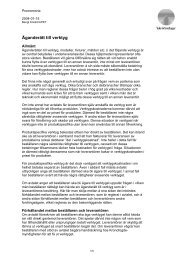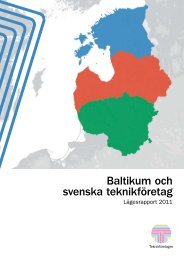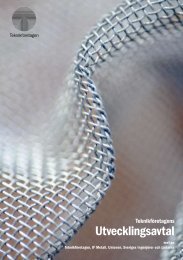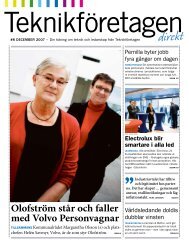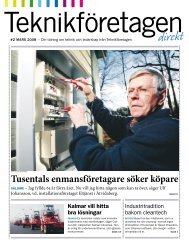The electrical machinery industry in India - Teknikföretagen
The electrical machinery industry in India - Teknikföretagen
The electrical machinery industry in India - Teknikföretagen
You also want an ePaper? Increase the reach of your titles
YUMPU automatically turns print PDFs into web optimized ePapers that Google loves.
Table of contentsOverview of the <strong>electrical</strong> <strong>mach<strong>in</strong>ery</strong> <strong><strong>in</strong>dustry</strong> <strong>in</strong> <strong>India</strong>...................................................... 5A snapshot of the <strong>India</strong>n <strong>electrical</strong> <strong>mach<strong>in</strong>ery</strong> <strong><strong>in</strong>dustry</strong>...................................................... 5Evolution of the <strong>India</strong>n <strong>electrical</strong> <strong>mach<strong>in</strong>ery</strong> <strong><strong>in</strong>dustry</strong>......................................................... 7Large manufacturers of <strong>electrical</strong> <strong>mach<strong>in</strong>ery</strong> <strong>in</strong> <strong>India</strong>.......................................................... 7Contribution of the <strong>electrical</strong> <strong>mach<strong>in</strong>ery</strong> <strong><strong>in</strong>dustry</strong> to the economy.................................. 11Growth of the <strong>electrical</strong> <strong>mach<strong>in</strong>ery</strong> <strong><strong>in</strong>dustry</strong>...................................................................... 12Pattern of development........................................................................................................ 17Size and structure of the heavy <strong>electrical</strong> <strong>mach<strong>in</strong>ery</strong> segment...................................... 18Turb<strong>in</strong>es and generators....................................................................................................... 19Transformers......................................................................................................................... 20Boilers.................................................................................................................................... 21Switchgear and control gear................................................................................................. 21Size and structure of the light <strong>electrical</strong> <strong>mach<strong>in</strong>ery</strong> segment........................................ 22Electrical wires and cables.................................................................................................... 22Transmission towers............................................................................................................. 23Cranes.................................................................................................................................... 23Lifts and escalators................................................................................................................ 24Batteries................................................................................................................................. 24Electrical lamps and tubes.................................................................................................... 26International trade................................................................................................................... 27Exports.................................................................................................................................. 27Imports.................................................................................................................................. 28Research and development................................................................................................... 30Future outlook.......................................................................................................................... 32References................................................................................................................................ 33
<strong>The</strong> country has been suffer<strong>in</strong>g due to unreliable power supply and it is estimatedthat <strong>India</strong> loses 1 per cent of its GDP due to the power problem. 1 Shortage of <strong>electrical</strong><strong>mach<strong>in</strong>ery</strong> for power generation is a major concern and although the largestmanufacturer <strong>in</strong> <strong>India</strong> is confident that demand for <strong>electrical</strong> <strong>mach<strong>in</strong>ery</strong> will be metby the supply of <strong>electrical</strong> <strong>mach<strong>in</strong>ery</strong>, many <strong><strong>in</strong>dustry</strong> experts are doubtful.<strong>The</strong> Government of <strong>India</strong> (GOI) has set ambitious targets for addition <strong>in</strong> powergeneration. It has also been encourag<strong>in</strong>g manufactur<strong>in</strong>g of <strong>electrical</strong> <strong>mach<strong>in</strong>ery</strong>through jo<strong>in</strong>t ventures with foreign manufacturers. An example of such collaborationis the recent jo<strong>in</strong>t venture between <strong>India</strong>n <strong>electrical</strong> <strong>mach<strong>in</strong>ery</strong> manufacturerLarsen & Toubro (L&T) and Mitsubishi Heavy Industries of Japan. 2 Hence, the currentshortage of <strong>electrical</strong> <strong>mach<strong>in</strong>ery</strong> can <strong>in</strong> turn be perceived as an opportunity formanufacturers of <strong>electrical</strong> <strong>mach<strong>in</strong>ery</strong> to setup operations <strong>in</strong> <strong>India</strong>.In fact, the <strong>electrical</strong> <strong>mach<strong>in</strong>ery</strong> <strong><strong>in</strong>dustry</strong> has been develop<strong>in</strong>g with an <strong>in</strong>creas<strong>in</strong>gamount of public – private participation and with an <strong>in</strong>creas<strong>in</strong>g number of foreigncollaborations for technology. 3 <strong>The</strong> <strong>electrical</strong> <strong>mach<strong>in</strong>ery</strong> <strong><strong>in</strong>dustry</strong> accounted for thelargest share of FDI <strong>in</strong>flows (cumulatively) between August 1991 and April 2007 at19.2 per cent. 4However, <strong>India</strong> imports a large amount of <strong>electrical</strong> <strong>mach<strong>in</strong>ery</strong> also. Measures arebe<strong>in</strong>g <strong>in</strong>itiated <strong>in</strong> this regard as <strong>India</strong> cannot rely on imports as that leads to loss of<strong>in</strong>vestments and employment with<strong>in</strong> the country. So, the <strong><strong>in</strong>dustry</strong> is expected to seea rise <strong>in</strong> the manufacture of <strong>electrical</strong> <strong>mach<strong>in</strong>ery</strong> across segments domestically <strong>in</strong>future. This is expected to spur development and growth of the Small and MediumEnterprises (SMEs) <strong>in</strong> the <strong><strong>in</strong>dustry</strong>.1) Reference has been made to the National Manufactur<strong>in</strong>g Competitiveness Council (2006)2) This <strong>in</strong>formation has been obta<strong>in</strong>ed from <strong>The</strong> H<strong>in</strong>du Bus<strong>in</strong>ess L<strong>in</strong>e (1st July 2008)3) This <strong>in</strong>formation has been obta<strong>in</strong>ed from M<strong>in</strong>istry of Commerce and Industry (2008)4) National Council for Applied Economic Research (August 2007) has been referred. National Council for AppliedEconomic Research is one of the foremost research th<strong>in</strong>k tanks <strong>in</strong> <strong>India</strong>6
Evolution of the <strong>India</strong>n <strong>electrical</strong> <strong>mach<strong>in</strong>ery</strong> <strong><strong>in</strong>dustry</strong>Throughout the 1990s and <strong>in</strong> recent years, <strong><strong>in</strong>dustry</strong> experts have been try<strong>in</strong>g to ascerta<strong>in</strong>methods to achieve and susta<strong>in</strong> growth across segments <strong>in</strong> the <strong><strong>in</strong>dustry</strong> andto help <strong>India</strong> become a manufactur<strong>in</strong>g hub. <strong>The</strong> ever <strong>in</strong>creas<strong>in</strong>g demand for power<strong>in</strong> <strong>India</strong> has led to a widen<strong>in</strong>g gap between the supply and demand of <strong>electrical</strong><strong>mach<strong>in</strong>ery</strong> to be able to service the planned developmental needs <strong>in</strong> <strong>India</strong>.In the past two decades the <strong><strong>in</strong>dustry</strong> has witnessed large scale consolidation. <strong>The</strong>consolidation has resulted <strong>in</strong> stronger companies with <strong>in</strong>creased size, economies ofscale, wider product ranges and enhanced f<strong>in</strong>ancial strength. Companies now havegreater access than before to foreign markets and higher barga<strong>in</strong><strong>in</strong>g power as a resultof comb<strong>in</strong>ed technological strengths through technology transfer from global majors.However, the <strong><strong>in</strong>dustry</strong> is still highly fragmented with more than 50 per cent of themanufacturers with a turnover of less than Rs. 500 million. This is because there aremany companies <strong>in</strong> the unorganized sector that manufacture transformers, switchgears,and other products <strong>in</strong> the lower technology fields. In the organized sector thedomestic manufacturers ma<strong>in</strong>ly consist of Public Sector Units (PSUs). 5Large manufacturers of <strong>electrical</strong> <strong>mach<strong>in</strong>ery</strong> <strong>in</strong> <strong>India</strong><strong>The</strong>re are a number of well established manufacturers across segments with<strong>in</strong> the<strong>electrical</strong> <strong>mach<strong>in</strong>ery</strong> <strong><strong>in</strong>dustry</strong> rang<strong>in</strong>g from mult<strong>in</strong>ational majors to large domesticmanufacturers and small scale manufacturers. <strong>The</strong> largest companies <strong>in</strong> the <strong><strong>in</strong>dustry</strong>form the heavy <strong>electrical</strong> <strong>mach<strong>in</strong>ery</strong> segment. S<strong>in</strong>ce the capital barrier to manufactureheavy <strong>electrical</strong> <strong>mach<strong>in</strong>ery</strong> is very high, a larger number of the small andunorganized manufacturers form part of the light <strong>electrical</strong> <strong>mach<strong>in</strong>ery</strong> segment.Further, many Fortune 100 companies are already sourc<strong>in</strong>g and manufactur<strong>in</strong>g <strong>electrical</strong><strong>mach<strong>in</strong>ery</strong> from <strong>India</strong>. <strong>The</strong>se companies expla<strong>in</strong> that their <strong>India</strong>n operationsthough small <strong>in</strong> size, are already reach<strong>in</strong>g if not exceed<strong>in</strong>g global cost and productivitybenchmarks. 65) Reference has been made to Department of Heavy Industry (2006)6) This <strong>in</strong>formation has been obta<strong>in</strong>ed from a report prepared by McK<strong>in</strong>sey & Company. See Luthra et. al.7
Share <strong>in</strong> production of <strong>India</strong>n companies<strong>India</strong> is the only develop<strong>in</strong>g country besides Ch<strong>in</strong>a, which produces the entire rangeof <strong>electrical</strong> power generation and transmission <strong>mach<strong>in</strong>ery</strong>. <strong>India</strong>n companies enjoymajority of the market share <strong>in</strong> production across most segments <strong>in</strong> the <strong><strong>in</strong>dustry</strong>.But a large number of collaborations with foreign manufacturers are tak<strong>in</strong>g place <strong>in</strong>the <strong><strong>in</strong>dustry</strong> lead<strong>in</strong>g to the growth of several jo<strong>in</strong>t venture companies. 7Strength of <strong>India</strong>n manufacturers lies <strong>in</strong> customiz<strong>in</strong>g effectivelyAccord<strong>in</strong>g to McK<strong>in</strong>sey & Company, mult<strong>in</strong>ational manufacturers should focustheir <strong>India</strong>n manufactur<strong>in</strong>g and sourc<strong>in</strong>g plans on custom based products. 8Accord<strong>in</strong>g to Mr. R.N. Misra, Executive Director, Bharat Heavy Electricals Limited,which is one of the largest companies <strong>in</strong> the <strong>electrical</strong> <strong>mach<strong>in</strong>ery</strong> <strong><strong>in</strong>dustry</strong>, Ch<strong>in</strong>a isthe readymade manufacturer whereas <strong>India</strong> is the tailor. 9Comparison of <strong>India</strong>n manufacturers with global leaders on certa<strong>in</strong> parameters<strong>India</strong>n manufacturers are yet to reach the k<strong>in</strong>d of competency levels global manufacturershave with regard to technology, delivery and quality parameters. On thecost parameter, common characteristics apply to the <strong>India</strong>n <strong>electrical</strong> <strong>mach<strong>in</strong>ery</strong><strong><strong>in</strong>dustry</strong> when compared with the western companies <strong>in</strong> the <strong><strong>in</strong>dustry</strong>. Accord<strong>in</strong>gto a report published by an <strong><strong>in</strong>dustry</strong> association <strong>India</strong>n Electronic and ElectricalManufacturers Association (IEEMA), the <strong>India</strong>n <strong>electrical</strong> <strong>mach<strong>in</strong>ery</strong> <strong><strong>in</strong>dustry</strong> isweak compared to global manufacturers with respect to automation <strong>in</strong> production,Research and Development (R&D) expenditure, tra<strong>in</strong><strong>in</strong>g and development. 10An example where a global major has manufactured <strong>in</strong> <strong>India</strong>to be competitive globallyABB, the large mult<strong>in</strong>ational company produc<strong>in</strong>g custom based <strong>electrical</strong> <strong>mach<strong>in</strong>ery</strong>is an example. It sources circuit breakers and magnetic actuators from its <strong>India</strong>n7) Reference has been made to M<strong>in</strong>istry of External Affairs (11th April 2008)8) This <strong>in</strong>formation has been obta<strong>in</strong>ed from a report prepared by McK<strong>in</strong>sey & Company. See Luthra et. al.9) Reference has been made to <strong>The</strong> H<strong>in</strong>du Bus<strong>in</strong>ess L<strong>in</strong>e (25th June 2008)10) Reference has been made to <strong>The</strong> H<strong>in</strong>du Bus<strong>in</strong>ess L<strong>in</strong>e (31st December 2007). IEEMA is the nodal <strong><strong>in</strong>dustry</strong>association for the <strong>electrical</strong> <strong>mach<strong>in</strong>ery</strong> manufactur<strong>in</strong>g <strong><strong>in</strong>dustry</strong>. Largest manufacturers <strong>in</strong> the <strong><strong>in</strong>dustry</strong> aremembers of this association.8
plant which was the first of its k<strong>in</strong>d among ABB’s facilities anywhere <strong>in</strong> the world tomanufacture a particular k<strong>in</strong>d of circuit breaker us<strong>in</strong>g only <strong>India</strong>n employees. Notonly was ABB able to achieve over 50 per cent <strong>in</strong> cost sav<strong>in</strong>gs, but it also managed toreduce the delivery period to two weeks from four weeks. 11Instance of a jo<strong>in</strong>t venture by a mult<strong>in</strong>ational <strong>in</strong> <strong>India</strong>An example of a large manufacturer want<strong>in</strong>g a foothold <strong>in</strong> the grow<strong>in</strong>g <strong>electrical</strong><strong>mach<strong>in</strong>ery</strong> <strong><strong>in</strong>dustry</strong> is Toshiba Corporation of Japan. It has formed a jo<strong>in</strong>t venturewith the JSW Group of <strong>India</strong> to manufacture turb<strong>in</strong>es and generators <strong>in</strong> <strong>India</strong>. Thisis go<strong>in</strong>g to be Toshiba’s second such manufactur<strong>in</strong>g base <strong>in</strong> the world.Mr. Atsuhiko Izumi, Executive Vice President of Toshiba Power Systems said, “Bycollaborat<strong>in</strong>g with JSW Group, we want to rapidly build up our presence <strong>in</strong> a fastgrow<strong>in</strong>g market and to contribute to secur<strong>in</strong>g a stable electricity supply <strong>in</strong> <strong>India</strong>.” 12<strong>The</strong> M<strong>in</strong>istry of Power is encourag<strong>in</strong>g <strong>in</strong>ternational players, <strong>in</strong>clud<strong>in</strong>g Italy’sAnsaldo, Czech Republic’s Skoda Power and South Korea’s Doosan Heavy Industriesand other such foreign companies to set up manufactur<strong>in</strong>g facilities <strong>in</strong> <strong>India</strong>. 13As mentioned earlier, there are a large number of domestic as well as foreign companies<strong>in</strong> <strong>India</strong>. <strong>The</strong>re are a large number of jo<strong>in</strong>t venture companies also. Givenbelow, is a table that briefly outl<strong>in</strong>es some of the largest companies <strong>in</strong> the <strong>electrical</strong><strong>mach<strong>in</strong>ery</strong> <strong><strong>in</strong>dustry</strong> <strong>in</strong> <strong>India</strong>.11) This <strong>in</strong>formation has been obta<strong>in</strong>ed from a report prepared by McK<strong>in</strong>sey & Company. See Luthra et. al.12) Reference has been made to <strong>The</strong> H<strong>in</strong>du Bus<strong>in</strong>ess L<strong>in</strong>e (8th May 2008)13) Reference has been made to <strong>The</strong> F<strong>in</strong>ancial Express (23rd October 2007)9
LARGE MANUFACTURERS WITHIN THE INDIAN ELECTRICAL MACHINERY INDUSTRYCompany descriptions and products manufactured are mentioned. <strong>The</strong> list is not exhaustive.ManufacturerCompany descriptionSectors/ ProductsABBCrompton GreavesBharat HeavyElectricals LimitedKirloskar ElectricHas 14 manufactur<strong>in</strong>g facilities and more than 6 500employees. ABB Group is leverag<strong>in</strong>g its <strong>India</strong> operationsfor projects, products, services, eng<strong>in</strong>eer<strong>in</strong>g,and R&D. <strong>India</strong> is a hub for the South Asia region.Started its <strong>India</strong> operations <strong>in</strong> 1937. One of <strong>India</strong>’slargest private sector companies. It is a diverse companyengaged <strong>in</strong> design<strong>in</strong>g, manufactur<strong>in</strong>g and market<strong>in</strong>gtechnologically advanced <strong>electrical</strong> <strong>mach<strong>in</strong>ery</strong>.Established more than 40 years ago, it is the largestcompany <strong>in</strong> the <strong><strong>in</strong>dustry</strong>. Its range of 180 productscater to power generation and transmission, transportation,telecom, and renewable energy <strong>in</strong>dustries.Established <strong>in</strong> 1946 it is one of <strong>India</strong>’s lead<strong>in</strong>g manufacturersof <strong>electrical</strong> <strong>mach<strong>in</strong>ery</strong> and power equipment.Is capable of manufactur<strong>in</strong>g a range of custommade products.Control systems, highvoltageproducts and systems,transformers, cables andaccessories and generators.Transformers, transmissionproducts, generators andlight<strong>in</strong>g products.Switchgears, boilers,turb<strong>in</strong>es, generators,transformers, compressors,capacitors etc.Motors, generators, switchgears,transformers, andother <strong>electrical</strong> productslike DC mach<strong>in</strong>es.Larsen & ToubroIt is one of the largest private sector companies <strong>in</strong>the bus<strong>in</strong>ess. It manufactures custom designed andeng<strong>in</strong>eered <strong>electrical</strong> <strong>mach<strong>in</strong>ery</strong> and systems.Switchgear, control andautomation systems andmeters, turb<strong>in</strong>e cas<strong>in</strong>gs etc.AlstomHavells<strong>The</strong>rmaxEmploys more than 3 300 people <strong>in</strong> <strong>India</strong> and has 4manufactur<strong>in</strong>g facilities. Alstom <strong>India</strong> has full capabilities<strong>in</strong> eng<strong>in</strong>eer<strong>in</strong>g, manufactur<strong>in</strong>g, project managementand supply of power generation equipment.One of the fastest grow<strong>in</strong>g <strong>in</strong>digenous <strong>electrical</strong> andpower distribution equipment manufactur<strong>in</strong>g companies.Employs over 8 000 employees and has manufactur<strong>in</strong>gfacilities spread across USA, Europe and Africa.Boilers, generators, turb<strong>in</strong>es,heat exchangers etc.Cables, switchgear, capacitorsand light<strong>in</strong>g equipment.An <strong>India</strong>n company hav<strong>in</strong>g 5 manufactur<strong>in</strong>g facilities Boilers and heaters are itsand has been <strong>in</strong> the bus<strong>in</strong>ess of manufactur<strong>in</strong>g major products<strong>electrical</strong> equipment for more than 3 decades. Its productsare sold <strong>in</strong> more than 40 countries worldwide.Source: Industry research and analysis. Websites of each of the companies have been used10
Contribution of the <strong>electrical</strong> <strong>mach<strong>in</strong>ery</strong> <strong><strong>in</strong>dustry</strong> to the economyMore than 95 per cent of the <strong>electrical</strong> <strong>mach<strong>in</strong>ery</strong> successfully <strong>in</strong>stalled <strong>in</strong> operation<strong>in</strong> <strong>India</strong> has been produced, <strong>in</strong>stalled and commissioned by the <strong>India</strong>n <strong>electrical</strong><strong>mach<strong>in</strong>ery</strong> <strong><strong>in</strong>dustry</strong> itself. Most of the products required for the <strong>in</strong>dustrial, commercial,and domestic sectors are manufactured by the <strong>India</strong>n <strong>electrical</strong> <strong>mach<strong>in</strong>ery</strong><strong><strong>in</strong>dustry</strong>. 14 <strong>India</strong> has developed strong capabilities <strong>in</strong> manufactur<strong>in</strong>g top-end andhigh technology products like transformers, turb<strong>in</strong>es and generators that are at parwith <strong>in</strong>ternational standards. <strong>The</strong> <strong><strong>in</strong>dustry</strong> had a volatile time dur<strong>in</strong>g the period1997–1998 to 2001–2002, but has been show<strong>in</strong>g positive trends s<strong>in</strong>ce 2002–2003.Among the two segments of the <strong><strong>in</strong>dustry</strong>, the heavy <strong>electrical</strong> <strong>mach<strong>in</strong>ery</strong> segment hasexhibited stronger growth than the light <strong>electrical</strong> <strong>mach<strong>in</strong>ery</strong> segment.Heavy <strong>electrical</strong> <strong>mach<strong>in</strong>ery</strong> segment has shown robust growth<strong>The</strong> heavy <strong>electrical</strong> <strong>mach<strong>in</strong>ery</strong> segment contributes more to the economy than thelight <strong>electrical</strong> <strong>mach<strong>in</strong>ery</strong> segment. Turb<strong>in</strong>es and boilers are two sub-segments thathave cont<strong>in</strong>uously shown robust <strong>in</strong>creases <strong>in</strong> growth s<strong>in</strong>ce the year 2004–2005. <strong>The</strong>boilers sub-segment is the largest sub-segment <strong>in</strong> the <strong><strong>in</strong>dustry</strong>. However, the switchgearand control gear sector has shown spectacular growth. 15TURNOVER OF sub-segments IN THE HEAVY ELECTRICAL MACHINERY SEGMENT<strong>The</strong> table below depicts turnover details between 2004–2005 and 2007–2008. Data shown is from Aprilto November for each year. Figures for switchgear and control gear are from April to March for each year.All figures are <strong>in</strong> Rs. Million except for figures of transformers which are <strong>in</strong> Million KVa. 16Sub-segment/Year 2004–2005 2005–2006 2006–2007 2007–2008Turb<strong>in</strong>es 2 598.05 4 471.06 6 695.94 11 511.10Generators 7 684.75 4 725.73 6 913.03 7 959.76Boilers 12 130.58 20 964.94 30 265.90 44 436.52Transformers (Million KVa) 31.61 41.21 44.14 42.32Switchgear & control gear* 1 890 Not available Not available 40 000Source: M<strong>in</strong>istry of Heavy Industries and Public Enterprises14) Reference has been made to <strong>India</strong>n Electrical and Electronics Manufacturers Association (2007)15) It is not clear if the turnover data for the switchgear and control gear sub-segment is accurate. However, the figurefor the sector <strong>in</strong> 2007–2008 is accurate.16) Reference has been made to M<strong>in</strong>istry of Heavy Industries and Public Enterprises (2008), M<strong>in</strong>istry of HeavyIndustries and Public Enterprises (2007), M<strong>in</strong>istry of Heavy Industries and Public Enterprises (2006), M<strong>in</strong>istry ofHeavy Industries and Public Enterprises (2005) and M<strong>in</strong>istry of Heavy Industries and Public Enterprises (2004)11
<strong>India</strong>’s per capita energy consumption is very low. With the grow<strong>in</strong>g economy,chang<strong>in</strong>g lifestyles, <strong>in</strong>creas<strong>in</strong>g electrification of rural and semi – urban areas, theconsumption of electricity is expected to <strong>in</strong>crease, lead<strong>in</strong>g to higher per capitaelectricity consumption. As per the M<strong>in</strong>istry of Power and the Central ElectricityAuthority (CEA), per capita electricity consumption is set to <strong>in</strong>crease from 585units <strong>in</strong> 2007–2008 to 1000 units by 2011–2012.From the figure below it can be <strong>in</strong>ferred that electricity consumption <strong>in</strong> <strong>India</strong> isconsiderably be lower than the average per capita electricity consumption <strong>in</strong> OECDcountries and some of its Asian neighbours. However, demand for electricity is setto <strong>in</strong>crease substantially <strong>in</strong> l<strong>in</strong>e with <strong>India</strong>’s growth path. 18PER CAPITA ELECTRICITY CONSUMPTION OF INDIA VIS A VIS OTHER REGIONS<strong>The</strong> table below depicts unit consumption of electricity <strong>in</strong> 2007–2008.13 0668 0447 0075852 4291 379<strong>India</strong> World average OECD countries USA Ch<strong>in</strong>a South KoreaSource: Industry research and analysis firm ASK <strong>India</strong> Securities Private LimitedSlow growth of the <strong><strong>in</strong>dustry</strong> <strong>in</strong> recent timesDespite ambitious growth targets for capacity expansion be<strong>in</strong>g set by the GOI andassurances be<strong>in</strong>g given, the ground reality is a little different. Slowdown of growth<strong>in</strong> power generation has led to a fall <strong>in</strong> the growth rate of the <strong>electrical</strong> <strong>mach<strong>in</strong>ery</strong>manufactur<strong>in</strong>g <strong><strong>in</strong>dustry</strong> <strong>in</strong> 2007–2008, as orders are not f<strong>in</strong>alized as planned. Accord<strong>in</strong>gto the President, IEEMA, Mr. Sunil More, the growth rate <strong>in</strong> the <strong><strong>in</strong>dustry</strong><strong>in</strong> 2007–2008 was slower than the growth rate <strong>in</strong> 2006–2007. He attributes these18) Reference has been made to ASK Securities <strong>India</strong> Private Limited (13th July 2007)13
easons to many factors, among which the major factor is non – f<strong>in</strong>alization of largeorders <strong>in</strong> the pipel<strong>in</strong>e by the Power Grid Corporation, which is one of the largestconsumers of <strong>electrical</strong> <strong>mach<strong>in</strong>ery</strong> <strong>in</strong> <strong>India</strong>.At the same time, accord<strong>in</strong>g to Mr. Sunil More, whenever the manufactur<strong>in</strong>g baseexpands the growth rate usually tapers downwards as compared to earlier rates,and this is what is happen<strong>in</strong>g to the <strong>electrical</strong> <strong>mach<strong>in</strong>ery</strong> <strong><strong>in</strong>dustry</strong> currently. So it isexpected that stronger growth rates will be demonstrated <strong>in</strong> the <strong><strong>in</strong>dustry</strong> <strong>in</strong> future. 19Advantages that are driv<strong>in</strong>g growth of the <strong><strong>in</strong>dustry</strong><strong>India</strong> has also made cont<strong>in</strong>uous improvements <strong>in</strong> terms of quality of manufacturedproducts, although it is yet to reach the quality standards of the global manufacturers<strong>in</strong> some cases. In comparison to some of the Asian tigers, <strong>India</strong>’s quality standardsare far more superior.<strong>India</strong> is <strong>in</strong> competition with Ch<strong>in</strong>a over the manufacture of <strong>electrical</strong> <strong>mach<strong>in</strong>ery</strong>ma<strong>in</strong>ly <strong>in</strong> terms of cost. However, the cost advantage that Ch<strong>in</strong>a enjoyed over <strong>India</strong><strong>in</strong> the last few years was <strong>in</strong> the range of 20–25 per cent whereas now that cost advantageover <strong>India</strong> is reduc<strong>in</strong>g and is now about 5 per cent. This can be attributedma<strong>in</strong>ly to subsidized raw materials, an artificially low valued currency of the Yuan<strong>in</strong> Ch<strong>in</strong>a, and lower <strong>in</strong>cidence of <strong>in</strong>direct taxes. <strong>India</strong>, on the other hand has costadvantages on account of lower logistics cost and delivery. 20Key strength of the <strong><strong>in</strong>dustry</strong> is <strong>in</strong> be<strong>in</strong>g able to customize manufactur<strong>in</strong>g of products<strong>India</strong> is able to manufacture both the standard products <strong>in</strong> some cases and alsocustomize products efficiently. For <strong>in</strong>stance, <strong>in</strong> the cases of boilers, Ch<strong>in</strong>a is ableto capitalize on advantages of economies of low cost raw materials and standardproducts like the 300 MW and the 600 MW boilers. Accord<strong>in</strong>g to Mr. R.N. Misra,Executive Director, Bharat Heavy Electricals Limited, Ch<strong>in</strong>a is the readymademanufacturer whereas <strong>India</strong> is the tailor. <strong>India</strong>n manufacturers are highly capableof be<strong>in</strong>g able to customize effectively to the benefit of the buy<strong>in</strong>g companies. Otherthan cost, delivery time is also key to performance. Recently a state electricity boarddisqualified a Ch<strong>in</strong>ese supplier because of a project delay of 2 years. 2119) Reference has been made to <strong>The</strong> H<strong>in</strong>du Bus<strong>in</strong>ess L<strong>in</strong>e (15th March 2008)20) Reference has been made to <strong>The</strong> H<strong>in</strong>du Bus<strong>in</strong>ess L<strong>in</strong>e (29th June 2008b)21) Reference has been made to <strong>The</strong> H<strong>in</strong>du Bus<strong>in</strong>ess L<strong>in</strong>e (25th June 2008)14
• ABB has been mak<strong>in</strong>g fresh <strong>in</strong>vestments <strong>in</strong> the country s<strong>in</strong>ce 2003–2004 andrecently announced plans to <strong>in</strong>vest a further USD 100 million between 2008 and2010 towards capacity expansion. ABB’s turnover is also expected to double by2009–2010 from that <strong>in</strong> 2007–2008.• <strong>The</strong> company wants to use <strong>India</strong> as a hub for Research & Development (R&D)and eng<strong>in</strong>eer<strong>in</strong>g to service other regions as well.• <strong>The</strong> company not only plans to use <strong>India</strong> as a low cost manufactur<strong>in</strong>g unit, butalso as a resource base for the Asia Pacific region for its operations worldwide.• <strong>The</strong> number of employees <strong>in</strong> ABB <strong>in</strong> <strong>India</strong> would double from 6 000 employees<strong>in</strong> 2007–2008 to 10 000 by 2009–2010. This number would be larger than thecomb<strong>in</strong>ed workforce <strong>in</strong> Sweden and Switzerland. 23Nuclear deal could lead to more bus<strong>in</strong>ess for <strong>electrical</strong> <strong>mach<strong>in</strong>ery</strong> manufacturers<strong>The</strong> nuclear deal with the United States of America (USA) is expected to generate alarge amount of demand for the <strong>electrical</strong> <strong>mach<strong>in</strong>ery</strong> <strong><strong>in</strong>dustry</strong>. This is because nuclearpower projects require similar k<strong>in</strong>d of <strong>mach<strong>in</strong>ery</strong> and equipment that thermalpower projects require with some modifications. <strong>The</strong> deal could prove to be highlybeneficial to many companies <strong>in</strong>volved <strong>in</strong> produc<strong>in</strong>g heavy <strong>electrical</strong> <strong>mach<strong>in</strong>ery</strong> likeABB, Larsen & Toubro, BHEL and EMCO etc.Bottlenecks <strong>in</strong> growth of the <strong>India</strong>n <strong>electrical</strong> <strong>mach<strong>in</strong>ery</strong> <strong><strong>in</strong>dustry</strong>Although <strong>India</strong> has certa<strong>in</strong> significant advantages that are help<strong>in</strong>g the <strong>in</strong>dustrialsector overall and the <strong>electrical</strong> <strong>mach<strong>in</strong>ery</strong> <strong><strong>in</strong>dustry</strong> also, there are bottlenecks thatcan <strong>in</strong>hibit the growth potential. Big challenges cited by <strong><strong>in</strong>dustry</strong> experts are timelyavailability of raw materials and <strong>in</strong>frastructural deficiencies. <strong>The</strong> GOI has set ambitiousplans to <strong>in</strong>crease the power generation capacity of <strong>India</strong>. However, there aredoubts about whether these targets will be achieved due to sluggish growth of thepower sector. This would also affect the <strong>electrical</strong> <strong>mach<strong>in</strong>ery</strong> <strong><strong>in</strong>dustry</strong>. At the sametime, power rema<strong>in</strong>s a high priority concern <strong>in</strong> <strong>India</strong> and development <strong>in</strong> the sectoris certa<strong>in</strong>. Hence, as the bottlenecks are removed, the power sector will develop, andthus demand for <strong>electrical</strong> <strong>mach<strong>in</strong>ery</strong> would grow.23) Reference has been made to <strong>The</strong> H<strong>in</strong>du Bus<strong>in</strong>ess L<strong>in</strong>e (4th December 2007)16
Pattern of developmentAs mentioned earlier, the <strong>electrical</strong> <strong>mach<strong>in</strong>ery</strong> <strong><strong>in</strong>dustry</strong>’s growth is be<strong>in</strong>g modelledon the successful cluster pattern of development adopted by the automotive <strong><strong>in</strong>dustry</strong><strong>in</strong> <strong>India</strong>.Scattered growth but segmentwise consolidation has begun<strong>The</strong> <strong>electrical</strong> <strong>mach<strong>in</strong>ery</strong> <strong><strong>in</strong>dustry</strong> is now try<strong>in</strong>g to nurture its suppliers <strong>in</strong> the sameway as <strong>in</strong> the automotive <strong><strong>in</strong>dustry</strong> and automotive components <strong><strong>in</strong>dustry</strong>. This planalso <strong>in</strong>cludes the small scale local suppliers. Further, efforts are be<strong>in</strong>g made to developthese suppliers not only for the domestic market but also for the global facilitiesof large companies like the French major Areva for <strong>in</strong>stance. 24<strong>The</strong> GOI is plann<strong>in</strong>g to create hubs for each segment. Recently, <strong>India</strong>’s largest powergeneration company National <strong>The</strong>rmal Power Corporation (NTPC) and BHEL formeda jo<strong>in</strong>t venture for manufactur<strong>in</strong>g <strong>electrical</strong> <strong>mach<strong>in</strong>ery</strong> to make up for the gap<strong>in</strong> demand and supply of <strong>electrical</strong> <strong>mach<strong>in</strong>ery</strong>. Both these companies are PSUs andthus the GOI exercises substantial <strong>in</strong>fluence on them. <strong>The</strong> GOI has proposed thatturb<strong>in</strong>es be manufactured <strong>in</strong> the city of Pune <strong>in</strong> West <strong>India</strong>, boilers be manufactured<strong>in</strong> the city of Vizag <strong>in</strong> East <strong>India</strong> and balance of plant equipment be manufactured<strong>in</strong> the state of West Bengal. 25Development of ultra mega power projects driv<strong>in</strong>g development<strong>The</strong> M<strong>in</strong>istry of Power has launched an <strong>in</strong>itiative for development of coal basedUltra Mega Power Projects (UMPP) <strong>in</strong> <strong>India</strong> each with a capacity of 4 000 MW andabove. Major sites have been identified <strong>in</strong> 5 states along the coast <strong>in</strong> Eastern andWestern <strong>India</strong>, and 3 states <strong>in</strong> central <strong>India</strong>.<strong>The</strong>se power projects are go<strong>in</strong>g to be developed on the basis that all <strong>mach<strong>in</strong>ery</strong> andequipment required will be manufactured domestically. Thus foreign manufacturersand jo<strong>in</strong>t venture companies will bid under the stipulation that <strong>electrical</strong><strong>mach<strong>in</strong>ery</strong> for the projects would only be supplied through <strong>in</strong>digenization of technology.This move has been made to provide impetus to the domestic manufactur<strong>in</strong>gsector, and is aimed at restrict<strong>in</strong>g imports of <strong>electrical</strong> <strong>mach<strong>in</strong>ery</strong>.24) Reference has been made to <strong>The</strong> H<strong>in</strong>du Bus<strong>in</strong>ess L<strong>in</strong>e (14th February 2006)25) Reference has been made to <strong>The</strong> H<strong>in</strong>du Bus<strong>in</strong>ess L<strong>in</strong>e (29th April 2008)17
<strong>The</strong> GOI is promot<strong>in</strong>g development of the <strong><strong>in</strong>dustry</strong> by enabl<strong>in</strong>g foreign and domesticmanufacturers to produce <strong>electrical</strong> <strong>mach<strong>in</strong>ery</strong> <strong>in</strong>digenously <strong>in</strong> <strong>India</strong>. <strong>The</strong>large scale power generation and expansion programme through UMPPs will helpdomestic manufactur<strong>in</strong>g and lead to growth of the <strong><strong>in</strong>dustry</strong> overall. 26Size and structure of the heavy <strong>electrical</strong><strong>mach<strong>in</strong>ery</strong> segmentHeavy <strong>electrical</strong> <strong>mach<strong>in</strong>ery</strong> covers <strong>mach<strong>in</strong>ery</strong> for power generation, transmission,distribution and utilization. This <strong>in</strong>cludes generators, boilers, various types ofturb<strong>in</strong>es, transformers, switchgears and other allied items. <strong>The</strong>se are used <strong>in</strong> multicoreprojects for power generation <strong>in</strong>clud<strong>in</strong>g nuclear power stations, petrochemicalcomplexes, chemical plants, <strong>in</strong>tegrated steel plants and metal units.<strong>The</strong> GOI has an ambitious mission of addition <strong>in</strong> generation of power named ‘ForAll 2012’. A capacity addition of 72 000 MW would be required to achieve power forall <strong>in</strong> <strong>India</strong>. This scale of expansion <strong>in</strong> capacity is expected to stimulate demand <strong>in</strong>a big way for heavy <strong>electrical</strong> <strong>mach<strong>in</strong>ery</strong>. <strong>The</strong> technology available <strong>in</strong> <strong>India</strong> is almostat par with that <strong>in</strong> the <strong>in</strong>ternational market barr<strong>in</strong>g some exceptions like high voltageequipment. 27It is believed that the history and growth of BHEL, symbolizes the overall growthpattern of the heavy <strong>electrical</strong> <strong>mach<strong>in</strong>ery</strong> <strong><strong>in</strong>dustry</strong> <strong>in</strong> the country. BHEL has theunique dist<strong>in</strong>ction of be<strong>in</strong>g one of the very few companies <strong>in</strong> the world, manufactur<strong>in</strong>gall major power generation equipment together under one roof. Now s<strong>in</strong>cethe demand for electricity has been <strong>in</strong>creas<strong>in</strong>g steadily, there is a burgeon<strong>in</strong>g needfor more <strong>electrical</strong> <strong>mach<strong>in</strong>ery</strong> manufacturers as BHEL alone is not able to fulfill theentire demand.<strong>The</strong> <strong><strong>in</strong>dustry</strong> has been upgrad<strong>in</strong>g the exist<strong>in</strong>g technology and is now capable oftak<strong>in</strong>g up turnkey contracts for export markets as well. <strong>The</strong> <strong><strong>in</strong>dustry</strong> has been delicensedand foreign collaborations are allowed with 100 percent FDI. <strong>The</strong> country isplann<strong>in</strong>g to add 150 000 MW to the power generation capacity <strong>in</strong> the next 10 years.This will generate substantial demand for heavy <strong>electrical</strong> <strong>mach<strong>in</strong>ery</strong>. 2826) Reference has been made to <strong>The</strong> H<strong>in</strong>du Bus<strong>in</strong>ess L<strong>in</strong>e (3rd May 2008)27) Reference has been made to <strong>The</strong> H<strong>in</strong>du Bus<strong>in</strong>ess L<strong>in</strong>e (23rd November 2006)28) Reference has been made to M<strong>in</strong>istry of External Affairs (11th April 2008)18
<strong>The</strong>re is a strong base for the manufacture of heavy <strong>electrical</strong> <strong>mach<strong>in</strong>ery</strong> <strong>in</strong> thecountry. <strong>The</strong> present buoyancy <strong>in</strong> the <strong>India</strong>n economy would further create demandfor <strong>electrical</strong> <strong>mach<strong>in</strong>ery</strong> through <strong>in</strong>dustrial growth and general economic development.Turb<strong>in</strong>es and generators<strong>The</strong> turb<strong>in</strong>es sub-segment of the <strong><strong>in</strong>dustry</strong> recorded a turnover of Rs. 11 511 million<strong>in</strong> the year 2007–2008 (April to November) grow<strong>in</strong>g at the rate of nearly 72 percent. <strong>The</strong>re are various k<strong>in</strong>ds of turb<strong>in</strong>es be<strong>in</strong>g produced <strong>in</strong> the country <strong>in</strong>clud<strong>in</strong>ggas turb<strong>in</strong>es, hydro turb<strong>in</strong>es and steam turb<strong>in</strong>es. BHEL has the largest <strong>in</strong>stalledcapacity of turb<strong>in</strong>es and generators <strong>in</strong> the country. However, there are private sectormanufacturers produc<strong>in</strong>g steam turb<strong>in</strong>es and gas turb<strong>in</strong>es also. <strong>The</strong> entire range ofturb<strong>in</strong>es is manufactured <strong>in</strong>clud<strong>in</strong>g steam turb<strong>in</strong>es of up to 660 MW. <strong>The</strong>re are facilitiesto manufacture turb<strong>in</strong>es up to 1 000 MW as well. Custom built conventionalhydro turb<strong>in</strong>es of Kaplan, Francis and Pelton types with match<strong>in</strong>g generators arealso produced <strong>in</strong>digenously <strong>in</strong> <strong>India</strong>. 29<strong>The</strong> generators sub-segment of the <strong><strong>in</strong>dustry</strong> recorded a turnover of Rs. 7 959.7million <strong>in</strong> the year 2007–2008 (April to November) grow<strong>in</strong>g at the rate of approximately15 per cent. Generators manufactured <strong>in</strong> <strong>India</strong> are at par with <strong>in</strong>ternationalgenerators and consistently deliver high performance. Domestic manufacturers arecapable of manufactur<strong>in</strong>g generators right from 0.5 KVA to 25 000 KVA and above.<strong>The</strong>re are a large number of jo<strong>in</strong>t venture partnerships be<strong>in</strong>g established <strong>in</strong> thissub-segment. In November 2007, L&T and Mitsubishi Heavy Industries Ltd, Japan,<strong>in</strong>ked a jo<strong>in</strong>t venture to set up a manufactur<strong>in</strong>g facility <strong>in</strong> <strong>India</strong> to manufacturesupercritical steam turb<strong>in</strong>e and generators. <strong>The</strong> product configuration would caterto plant capacities rang<strong>in</strong>g between 500 MW and 1 000 MW.Cumm<strong>in</strong>s Generator Technologies <strong>India</strong> Private Limited (CGTIL) is one of the largegenerator manufactur<strong>in</strong>g companies <strong>in</strong> <strong>India</strong>. It is sett<strong>in</strong>g up plants across <strong>India</strong>aggressively. In addition to expand<strong>in</strong>g <strong>in</strong> the domestic market, CGTIL is all set tobecome a major export hub for its markets <strong>in</strong> other parts of the world such as WestAsia, Ch<strong>in</strong>a, Lat<strong>in</strong> America, Africa and some countries <strong>in</strong> Eastern Europe. 3029) Reference has been made to M<strong>in</strong>istry of Heavy Industries and Public Enterprises (2008)30) Reference has been made to <strong>The</strong> H<strong>in</strong>du Bus<strong>in</strong>ess L<strong>in</strong>e (11th January 2008) and <strong>The</strong> H<strong>in</strong>du Bus<strong>in</strong>ess L<strong>in</strong>e(15th January 2008)19
Transformers<strong>The</strong> transformers sub-segment of the <strong><strong>in</strong>dustry</strong> recorded production of 42.32 MillionKva <strong>in</strong> the year 2007–2008 (April to November). <strong>The</strong> sub-segment decl<strong>in</strong>ed by4.30 per cent dur<strong>in</strong>g the period. <strong>The</strong> transformer <strong><strong>in</strong>dustry</strong> <strong>in</strong> <strong>India</strong> has developedfor over 50 years and has a well matured technology base. <strong>The</strong> <strong>India</strong>n transformer<strong><strong>in</strong>dustry</strong> is oligopolistic <strong>in</strong> nature with the top six players hav<strong>in</strong>g more than80 per cent share <strong>in</strong> the sub-segment. 31 <strong>The</strong>se <strong>in</strong>clude Siemens, ABB, Schneider,BHEL, Crompton Greaves and EMCO. <strong>The</strong> long process of qualification with StateElectricity Boards (SEBs) and a multitude of regulations act as entry barriers fornew players. <strong>The</strong> health of the transformer <strong><strong>in</strong>dustry</strong> depends largely on the powergeneration and transmission sector. <strong>The</strong> major users of this <strong><strong>in</strong>dustry</strong> are the SEBsand <strong>in</strong>dustries. 32<strong>The</strong> <strong><strong>in</strong>dustry</strong> has the technology to manufacture a wide range of power transformers,distribution transformers and special transformers for weld<strong>in</strong>g, traction andfurnaces etc. Energy efficient transformers with low losses and low noise levelsare also be<strong>in</strong>g developed to meet <strong>in</strong>ternational requirements. <strong>The</strong> domestic transformer<strong><strong>in</strong>dustry</strong> is well established with the capability to provide state of-the-artequipment. <strong>The</strong> <strong><strong>in</strong>dustry</strong> has the capacity to manufacture the whole range of powerand distribution transformers <strong>in</strong>clud<strong>in</strong>g the extra high voltage ranges. Siemensthe global power equipment manufacturer has setup a new plant near Mumbai, <strong>in</strong>Western <strong>India</strong>. It aims to use this facility to reach markets <strong>in</strong> West Asia and SAARCcountries. Mr. J. Schubert, Manag<strong>in</strong>g Director, Siemens, said that <strong>in</strong> view of theopportunities <strong>in</strong> <strong>India</strong> and the overseas market, the company is first plann<strong>in</strong>g to stabilizeand then ramp up transformer production. 33 Kirloskar Power Equipments Ltdhas announced the <strong>in</strong>auguration of a greenfield manufactur<strong>in</strong>g unit at Kondhapuri,near Pune <strong>in</strong> West <strong>India</strong>. <strong>The</strong> new facility will help enhance manufactur<strong>in</strong>g capacityto meet the robust demand for transformers <strong>in</strong> <strong>India</strong> and abroad. Kirloskar PowerEquipments has established itself as a key player <strong>in</strong> the <strong>India</strong>n transformer <strong><strong>in</strong>dustry</strong>.Voltamp Transformers, Emco Ltd and Indo Tech Transformers Ltd are also expectedto be the major beneficiaries of the <strong>in</strong>creased demand <strong>in</strong> the Power sub-segment. 34Mr Hitul Gutka, Power Analyst, <strong>India</strong> Infol<strong>in</strong>e Ltd said that the rural electrification<strong>in</strong>itiative of the GOI would lead to ris<strong>in</strong>g demand for transformers. <strong>The</strong> growth <strong>in</strong>31) Reference has been made to SSKI <strong>India</strong> Research (21st February 2005)32) Reference has been made to Department of Heavy Industry (2006)33) Reference has been made to <strong>The</strong> H<strong>in</strong>du Bus<strong>in</strong>ess L<strong>in</strong>e (5th December 2007)34) Reference has been made to <strong>The</strong> H<strong>in</strong>du Bus<strong>in</strong>ess L<strong>in</strong>e (3rd April 2008)20
<strong>in</strong>frastructure and hous<strong>in</strong>g <strong>in</strong> <strong>India</strong> will also generate further demand for power.Large number of new malls, hotels and IT parks be<strong>in</strong>g developed will also result <strong>in</strong>large consumption of power, say analysts. ”Almost one fourth of the total <strong>in</strong>vestment<strong>in</strong> power generation goes towards transformers, which <strong>in</strong>dicates that over thenext five years, at least Rs 1 000 billion should be spent on the transformer <strong><strong>in</strong>dustry</strong>.”said Mr Mehul Mukati, Power Analyst, Emkay Shares and Stock Brokers Ltd. 35BoilersIn terms of turnover, Boilers is the largest sub-segment of the heavy <strong>electrical</strong><strong>mach<strong>in</strong>ery</strong> segment and hence <strong>in</strong> the <strong>electrical</strong> <strong>mach<strong>in</strong>ery</strong> <strong><strong>in</strong>dustry</strong> as well. <strong>The</strong>sub-segments turnover <strong>in</strong> the year 2007–2008 (April to November) was Rs. 44 436.5million. <strong>The</strong> sub-segment recorded the second fastest growth <strong>in</strong> the heavy <strong>mach<strong>in</strong>ery</strong>segment of 46.82 per cent dur<strong>in</strong>g the period. With the <strong>in</strong>creas<strong>in</strong>g demand forpower <strong>in</strong> <strong>India</strong> and expansion of power generation capacities <strong>in</strong> <strong>India</strong> <strong>in</strong> view of theEleventh Five Year Plan, production of boilers is set to expand substantially record<strong>in</strong>gstrong growth rates for the years to come.Bharat Heavy Electricals Limited (BHEL) is the largest manufacturer of boilers <strong>in</strong>the country (with more than 60 per cent market share) and has the capacity to manufactureboilers for thermal power plants apart from utility boilers and <strong>in</strong>dustrialboilers. <strong>The</strong> <strong><strong>in</strong>dustry</strong> has the capability to manufacture boilers with super criticalparameters up to 1 000 MW <strong>in</strong> size.Switchgear and control gear<strong>The</strong> switchgear and control gear sub-segment <strong>in</strong> <strong>India</strong> is fully developed, produc<strong>in</strong>g,and supply<strong>in</strong>g a wide range of switchgear and control gear. It is estimated that thepresent size of the switchgear market is more than Rs. 40 billion. <strong>The</strong> sub-segmentis competitive <strong>in</strong> the field of design and eng<strong>in</strong>eer<strong>in</strong>g as the skill sets available <strong>in</strong> thecountry are relatively less expensive. Cont<strong>in</strong>uous power supply is a crucial requirementnot only for <strong><strong>in</strong>dustry</strong> but also for every other use of electricity. In <strong>India</strong>, theentire range of circuit breakers from bulk oil, m<strong>in</strong>imum oil, air blast, vacuum to SF6are manufactured to standard specifications for customers. <strong>The</strong> ranges of productsproduced cover the entire voltage range for switchgear and control gear, M<strong>in</strong>iatureCircuit Breakers (MCBs), air circuit breakers, switches, rewireable fuses and HRCfuses with their respective fuse bases, holders and starters. Switchgear and controlgear are <strong>in</strong>dispensable both <strong>in</strong> transmission and distribution of power and hence35) Reference has been made to <strong>The</strong> H<strong>in</strong>du Bus<strong>in</strong>ess L<strong>in</strong>e (20th January 2007)21
with the <strong>in</strong>crease <strong>in</strong> power generation and transmission, a substantial <strong>in</strong>crease <strong>in</strong>growth of this sub-segment of the <strong><strong>in</strong>dustry</strong> is foreseen. 36Size and structure of the light <strong>electrical</strong><strong>mach<strong>in</strong>ery</strong> segment<strong>The</strong> light <strong>electrical</strong> <strong>mach<strong>in</strong>ery</strong> sub-segment is diverse hav<strong>in</strong>g a number of dist<strong>in</strong>ctproducts and sub-products. It <strong>in</strong>cludes <strong>in</strong>dustrial goods like <strong>electrical</strong> wires andcables, transmission towers, cranes, lifts and escalators, storage batteries and dry cellbatteries and <strong>electrical</strong> lamps. A brief on each of the sub-segments with<strong>in</strong> the light<strong>electrical</strong> <strong>mach<strong>in</strong>ery</strong> segment is given below.Electrical wires and cablesWires and cables made of fibre optics, iron or nonferrous (copper, z<strong>in</strong>c, alum<strong>in</strong>ium),play an important role <strong>in</strong> most areas of <strong>in</strong>dustrial activities and daily life. <strong>The</strong><strong>electrical</strong> wires and cables <strong><strong>in</strong>dustry</strong> is one of the earliest <strong>in</strong>dustries established <strong>in</strong>the country <strong>in</strong> the field of <strong>electrical</strong> <strong>mach<strong>in</strong>ery</strong>. A wide range of wires and cables aremanufactured <strong>in</strong>clud<strong>in</strong>g communication cables such as telephone cables, optic fibercables, local area network cables, switchboard cables, coaxial cables, VSAT cables,<strong>electrical</strong> cables such as <strong>electrical</strong> wires, w<strong>in</strong>d<strong>in</strong>g wires, automotive/battery cables,UPS cables, flexible wires, low voltage power cables and EHT power cables.<strong>The</strong> major user <strong>in</strong>dustries of wires and cables are the power, <strong>electrical</strong> <strong>mach<strong>in</strong>ery</strong>,electronic equipment, telecom, enterta<strong>in</strong>ment and construction <strong>in</strong>dustries. With<strong>in</strong>frastructure receiv<strong>in</strong>g priority attention from the GOI, construction, power andtelecom <strong>in</strong>dustries are develop<strong>in</strong>g fast. This development will give a boost to thewires and cables <strong>in</strong>dustries. In 2006–2007, production of wires and cables wasreported to be 817 000 core kilometres. Dur<strong>in</strong>g the year 2007–2008 (up to December2007), the reported production of <strong>electrical</strong> wires and cables was over 2 093 000core kilometres. 37With advancements and developments <strong>in</strong> the <strong><strong>in</strong>dustry</strong>, manufacture of buss ductshas also begun <strong>in</strong> <strong>India</strong> for safe transport of electricity <strong>in</strong> multistoried build<strong>in</strong>gs.Some major global manufactures have also started manufactur<strong>in</strong>g <strong>in</strong> this segment.For <strong>in</strong>stance, Eaton Power Quality Private Ltd (EPQPL), the <strong>electrical</strong> products36) Reference has been made to <strong>The</strong> H<strong>in</strong>du Bus<strong>in</strong>ess L<strong>in</strong>e (3rd May 2008)37) Reference has been made to M<strong>in</strong>istry of Commerce and Industry (2008)22
division of the large USA based corporation, is gear<strong>in</strong>g up to focus aggressively onbuss ducts <strong>in</strong> <strong>India</strong> – a replacement for power cables which helps highrise build<strong>in</strong>gsto save on cost of ownership. 38Transmission towersKeep<strong>in</strong>g pace with growth of <strong>in</strong>dustries <strong>in</strong> the country and a spurt <strong>in</strong> the domesticdemand for power, the <strong>electrical</strong> energy sector is grow<strong>in</strong>g at a rapid pace. <strong>The</strong>re isan <strong>in</strong>creas<strong>in</strong>g shift <strong>in</strong> <strong>India</strong> to have larger power stations, particularly super thermalpower stations.Consequently, while there would be less but larger power generat<strong>in</strong>g stations, thedemand for transmission of energy is expected to grow substantially. <strong>The</strong> transmissionnetwork of an <strong>electrical</strong> power utility constitutes a critical part of the wholepower system. <strong>The</strong> country has sufficient capacity to cater to the demands aris<strong>in</strong>g<strong>in</strong> the country and also for exports. <strong>The</strong> <strong><strong>in</strong>dustry</strong> has set up facilities for test<strong>in</strong>gtransmission towers up to 1 000 KV with the objective of cater<strong>in</strong>g to future growthof transmission systems <strong>in</strong> the country as well as for exports. 39An encourag<strong>in</strong>g <strong>in</strong>vestment environment, ma<strong>in</strong>tenance led upgradation programmesand new Transmission and Distribution (T&D) network rollouts are expectedto cont<strong>in</strong>ue to propel growth <strong>in</strong> this segment. <strong>The</strong> Eleventh Plan (2007–2012) islikely to see an <strong>in</strong>vestment of around Rs 2 475 billion for the expansion of the transmission<strong>in</strong>frastructure. 40CranesA wide range of cranes are manufactured <strong>in</strong> the country. <strong>The</strong>se <strong>in</strong>clude ElectricOverhead Travel<strong>in</strong>g (EOT) cranes, mobile cranes, ladle cranes, hydraulic decks, crabcranes, float<strong>in</strong>g cranes, controller cranes etc. <strong>The</strong>re is a good potential for growth ofthis the sub-segment, <strong>in</strong> view of <strong>in</strong>creased <strong>in</strong>dustrial activities <strong>in</strong> various fields, aswell as the construction <strong><strong>in</strong>dustry</strong>. In 2006–2007, the sub-segment reported productionof 19 056 tonnes of cranes. Hence it has not been witness<strong>in</strong>g strong growth ratesbut has been grow<strong>in</strong>g steadily over the past few years and is expected to cont<strong>in</strong>ue togrow this way <strong>in</strong> the future.38) <strong>The</strong> H<strong>in</strong>du Bus<strong>in</strong>ess L<strong>in</strong>e (27th June 2008) has been referred39) Reference has been made to M<strong>in</strong>istry of Commerce and Industry (2008)40) <strong>The</strong> H<strong>in</strong>du Bus<strong>in</strong>ess L<strong>in</strong>e (13th January 2007) has been referred23
Lifts and escalatorsLifts and escalators have evolved <strong>in</strong>to sophisticated, safe and simple systems, tosuit the requirements of various diverse users, with the help of latest <strong>in</strong>novation <strong>in</strong>technology. A wide range of lifts and escalators are manufactured <strong>in</strong> <strong>India</strong>. <strong>The</strong>se<strong>in</strong>clude s<strong>in</strong>gle speed, double speed, gearless, hydraulic, servo and Variable VoltageVariable Frequency (VVVF) elevators. Dur<strong>in</strong>g the year 2007–2008 (up to December2007) the production was reported at 6 370 numbers. 41Rid<strong>in</strong>g high on the realty boom, the elevator and escalator <strong><strong>in</strong>dustry</strong> has seen a near25 per cent growth over the last three to four years. In the year 2007–2008 the estimatedturnover was about Rs 42 billion. <strong>The</strong> use of lifts and escalators is <strong>in</strong>creas<strong>in</strong>grapidly, due to substantial <strong>in</strong>vestments <strong>in</strong> the construction of multistoried hous<strong>in</strong>gcomplexes, large malls and supermarkets of <strong>in</strong>ternational standards, modernizationof airports and railway stations.“As of now, escalators are imported, mostly from Ch<strong>in</strong>a, and conform to the Europeannorms” says Mr. T.A.K. Mathews, a qualified elevator <strong>in</strong>spector accredited bythe US-based National Association of Elevator Safety. A third of the elevator marketis serviced by the unorganized sector.It is the ‘consistency of material’ performance that puts a question mark on suppliesmade by the unorganized sector. Moreover, the ground-plus-six floor segment iscatered to largely by the unorganized sector whose prices are almost half that of theorganized sector players. As cities grow vertically, lifts and escalators become the lifel<strong>in</strong>e for the build<strong>in</strong>gs that constitute this development. Rapid urbanization, robustactivity <strong>in</strong> the construction <strong><strong>in</strong>dustry</strong> and corporatization of the real estate sector hasled to a healthy growth of this <strong><strong>in</strong>dustry</strong>. 42Batteries<strong>The</strong> <strong>India</strong>n battery manufactur<strong>in</strong>g <strong><strong>in</strong>dustry</strong> is matur<strong>in</strong>g and growth is not onlybe<strong>in</strong>g driven by the automotive <strong><strong>in</strong>dustry</strong> but also by other <strong>in</strong>dustries like telecom,railways, power and other <strong>in</strong>dustrial applications. With an <strong>in</strong>creas<strong>in</strong>g number ofglobal automotive manufacturers mak<strong>in</strong>g <strong>India</strong> a hub for exports to other countries<strong>in</strong> Asia and SAARC countries, the overall market base for batteries has been enhancedsubstantially. At the same time due to strong growth <strong>in</strong> the economy and the<strong>in</strong>dustrial sector, the demand for <strong>in</strong>dustrial batteries has also been robust. With the41) Reference has been made to M<strong>in</strong>istry of Commerce and Industry (2008)42) <strong>The</strong> H<strong>in</strong>du Bus<strong>in</strong>ess L<strong>in</strong>e (25th February 2008) has been referred24
country short of power <strong>in</strong> several pockets, usage of <strong>in</strong>verters too, has gone up significantly,and this is not expected to come down soon.<strong>The</strong> domestic battery <strong><strong>in</strong>dustry</strong> <strong>in</strong> <strong>India</strong> is poised to more than double with<strong>in</strong> fouryears given the current rate of growth of over 20 per cent per annum, accord<strong>in</strong>g toMr S.B. Ganguly, Chairman, Exide Industries Ltd. 43 Given the market potential, forthe first time an International Battery Fair is be<strong>in</strong>g hosted <strong>in</strong> <strong>India</strong>, normally hosted<strong>in</strong> the US, Europe and <strong>in</strong> the Asia-Pacific markets. This shows how the global marketis view<strong>in</strong>g <strong>India</strong> and its bus<strong>in</strong>ess prospects.<strong>The</strong>re are major manufacturers <strong>in</strong> the country like Exide, Amco Yuasa, Amaron,Panasonic, Duracell, there are a large number of small manufacturers <strong>in</strong> the unorganizedmarket. Mr Ganguly said that the organised sector accounts for Rs 50 billion,and the unorganised sector accounts for about three times that amount i.e. Rs.150 billion. 44 Dur<strong>in</strong>g the year 2006–2007, the organized sector recorded productionof 40.11 million units. 45<strong>The</strong> battery <strong><strong>in</strong>dustry</strong> can be divided <strong>in</strong>to two parts, lead acid batteries and dry cellbatteries. Lead acid batteries are used <strong>in</strong> vehicles and are also used for <strong>in</strong>dustrialpurposes such as backup power for UPS applications, control rooms, power stationsetc. However, the major user of these batteries is the automotive <strong><strong>in</strong>dustry</strong>. Inaddition, these are also used for supply<strong>in</strong>g power <strong>in</strong> emergency lights, telephonesystems, mach<strong>in</strong>e tools and material handl<strong>in</strong>g equipment. A new application ofthese batteries is <strong>in</strong> electric vehicles.Dry cell batteries are the oldest type of batteries still be<strong>in</strong>g used. Performance ofthese batteries has undergone progressive improvements through technologicaldevelopments. Although there have been improvements <strong>in</strong> manufacture of dry cells,the basic structure rema<strong>in</strong>s the same. In the liberalized economic environment,<strong>in</strong>expensive batteries like rechargeable cells are com<strong>in</strong>g <strong>in</strong>to the market. New typesof dry cell batteries with a longer shelf life and greater dependability have also comeup. Leak proof dry cells are used <strong>in</strong> expensive electronic/auto equipment and toys.Nickel cadmium batteries and other rechargeable batteries are manufactured tomeet the requirements <strong>in</strong> defence, telecommunications and electronics.43) Exide is one of the largest battery manufactur<strong>in</strong>g companies <strong>in</strong> <strong>India</strong>44) <strong>The</strong> H<strong>in</strong>du Bus<strong>in</strong>ess L<strong>in</strong>e (13th March 2008) has been referred45) Reference has been made to M<strong>in</strong>istry of Commerce and Industry (2008)25
Environment friendly alkal<strong>in</strong>e batteries, which are mercury free, are also be<strong>in</strong>gmanufactured <strong>in</strong> the country. Though the usage of high dra<strong>in</strong> applications is yet topick up <strong>in</strong> the country, the grow<strong>in</strong>g popularity of cellular phones, laptops and importedtoys could open the market for a new range of batteries that are not producedat present. <strong>The</strong> production of dry cells <strong>in</strong> the organized sector <strong>in</strong> 2006–2007 wasreported to be 2552.33 million numbers. 46Electrical lamps and tubes<strong>The</strong> emphasis on the power sector and its phenomenal growth and distribution laidthe foundation for the light<strong>in</strong>g <strong><strong>in</strong>dustry</strong> <strong>in</strong> <strong>India</strong>. Electric light<strong>in</strong>g <strong><strong>in</strong>dustry</strong> is welldeveloped <strong>in</strong> the country. A wide range of lamps and tubes are manufactured <strong>in</strong> thecountry which <strong>in</strong>clude General Light<strong>in</strong>g Service (GLS) lamps, such as <strong>in</strong>candescentbulbs, halogen lamps, gas discharge lamps, such as fluorescent tube lights, compactfluorescent lamps, high pressure mercury vapour lamps, metal halide lamps, lowpressure and high pressure sodium vapour lamps and a variety of special lamps.<strong>The</strong> higher energy cost has led to the development of energy efficient lamps consum<strong>in</strong>gless power and giv<strong>in</strong>g output as close to daylight. Compact FluorescentLamps (CFL), which consume about 20 per cent of the electricity for the same lightoutput and last up to 10 times longer than the GLS lamps are gett<strong>in</strong>g more popular.Manufacturers are adopt<strong>in</strong>g imported designs and know-how through technicalcollaborations.<strong>The</strong>re has been an effective widen<strong>in</strong>g of the locally produced range of lamps, alongwith the serious advent of electronic equipment <strong>in</strong> light<strong>in</strong>g, thereby supply<strong>in</strong>gbetter, more efficient and cheaper light<strong>in</strong>g systems with improved aesthetics. <strong>The</strong>future of the <strong><strong>in</strong>dustry</strong> envisages immense prospects of growth and development fortechnologically advanced and cost effective organization. M<strong>in</strong>iaturization, electroniccircuitry, newer chemicals and better lum<strong>in</strong>aries are all provid<strong>in</strong>g the world withproducts of larger light output at m<strong>in</strong>imum cost help<strong>in</strong>g energy conservation.<strong>The</strong> growth of the <strong><strong>in</strong>dustry</strong> has been substantial dur<strong>in</strong>g the last few years. <strong>The</strong> productionof GLS lamps <strong>in</strong> the organized sector <strong>in</strong> 2006–2007 is reported to be 470.46million, whereas the production of fluorescent tubes <strong>in</strong> the same period was 209.02million. 4746) Reference has been made to M<strong>in</strong>istry of Commerce and Industry (2008)47) Reference has been made to M<strong>in</strong>istry of Commerce and Industry (2008)26
International trade<strong>The</strong> largest sub-segments <strong>in</strong> the <strong>electrical</strong> <strong>mach<strong>in</strong>ery</strong> <strong>in</strong> terms of exports are turb<strong>in</strong>esand generators and transformers <strong>in</strong> the heavy <strong>electrical</strong> <strong>mach<strong>in</strong>ery</strong> segment andwires and cables <strong>in</strong> the light <strong>electrical</strong> <strong>mach<strong>in</strong>ery</strong> segment. In case of turb<strong>in</strong>es andgenerators and transformers, a bulk of the exports is made by BHEL. With <strong>in</strong>creas<strong>in</strong>gdemand <strong>in</strong> the domestic market the focus of the <strong>India</strong>n manufacturers hasbeen <strong>in</strong> <strong>India</strong> but <strong>in</strong> the recent past they have been mak<strong>in</strong>g forays <strong>in</strong>to other markets<strong>in</strong> Africa, Europe and Asia also.ExportsAs mentioned earlier, the <strong>India</strong>n manufacturers did not focus on export<strong>in</strong>g to othermarkets around the world. However a start has been made now. This can be seen bystudy<strong>in</strong>g the trends <strong>in</strong> exports of the high value and high skill products <strong>in</strong> the heavy<strong>electrical</strong> <strong>mach<strong>in</strong>ery</strong> segment, with turb<strong>in</strong>es and generators and transformers. Boththese segments have seen very strong growth rates from 2003–2004 to 2006–2007.Other sub-segments too have been grow<strong>in</strong>g <strong>in</strong> terms of exports.EXPORTS OF Sub-segments WITHIN THE HEAVY ELECTRICAL MACHINERY SEGMENT<strong>The</strong> table below depicts export details between 2003–2004 and 2006–2007. All figures are <strong>in</strong> Rs. Million.Sub-segment/Year 2003–2004 2004–2005 2005–2006 2006–2007Turb<strong>in</strong>es and generators 2 392.8 5 899.6 5 650.0 21 000.0Boilers 1 560.6 2 239.0 2 420.0 3 950.0Transformers 7 783.3 8 983.2 16 400.0 29 230.0Switchgear & control gear 6 543.1 7 185.3 11 080.0 14 640.0Source: M<strong>in</strong>istry of Heavy Industries and Public EnterprisesWith rapid <strong>in</strong>crease <strong>in</strong> development <strong>in</strong> <strong>in</strong>frastructure there has been an <strong>in</strong>crease <strong>in</strong>production and export of <strong>electrical</strong> wires and cables. With more such developmentexpected <strong>in</strong> the years to come exports <strong>in</strong> this segment are expected to cont<strong>in</strong>ue toboom. Although the production of cranes <strong>in</strong> <strong>India</strong> has been <strong>in</strong>creas<strong>in</strong>g at a very fast27
pace, export of cranes is not a focus area and production is ma<strong>in</strong>ly expected to caterto the domestic demand only. 48EXPORTS OF sub-segments WITHIN THE LIGHT ELECTRICAL MACHINERY SEGMENT<strong>The</strong> table below depicts exports details between 2005–2006 and 2006–2007. All figures are <strong>in</strong> Rs. Million.Sub-segment/Year 2005–2006 2006–2007Electrical wires & cables 7 247.0 15 207.0Transmission towers 3 123.0 5 707.0Cranes 957.6 834.0Lead acid batteries 2 007.0 2 593.0Dry cell batteries 414.0 515.0Source: M<strong>in</strong>istry of Commerce and Industry* Figures for lifts and escalators were not available. Data for exports for years prior to 2005–2006 was not available.Imports<strong>India</strong> rema<strong>in</strong>s a major importer of <strong>electrical</strong> <strong>mach<strong>in</strong>ery</strong> across the heavy and light<strong>electrical</strong> <strong>mach<strong>in</strong>ery</strong> segments. In the heavy <strong>electrical</strong> <strong>mach<strong>in</strong>ery</strong> segment the importsare more than exports <strong>in</strong> turb<strong>in</strong>es and generators and transformers segments.Although there has been tremendous growth <strong>in</strong> production <strong>in</strong> the turb<strong>in</strong>es andgenerators segment there has also been significant growth <strong>in</strong> imports from 2003–2004 till 2006–2007. This can be attributed to the shortage <strong>in</strong> production <strong>in</strong> <strong>India</strong> tomatch the demand for turb<strong>in</strong>es and generators.It is the same <strong>in</strong> case of switchgear and control gear. With more and more foreignparticipation be<strong>in</strong>g encouraged, the heavy <strong>electrical</strong> <strong>mach<strong>in</strong>ery</strong> segment is expectedto cont<strong>in</strong>ue to import <strong>in</strong> large numbers. 4948) Reference has been made to M<strong>in</strong>istry of Heavy Industries and Public Enterprises (2008), M<strong>in</strong>istry of Heavy Industriesand Public Enterprises (2007), M<strong>in</strong>istry of Heavy Industries and Public Enterprises (2006), M<strong>in</strong>istry of HeavyIndustries and Public Enterprises (2005) and M<strong>in</strong>istry of Heavy Industries and Public Enterprises (2004)49) Reference has been made to M<strong>in</strong>istry of Commerce and Industry (2008), M<strong>in</strong>istry of Commerce and Industry(2007), and M<strong>in</strong>istry of Commerce and Industry (2006)28
IMPORTS OF Sub-segmentS WITHIN THE HEAVY ELECTRICAL MACHINERY SEGMENT<strong>The</strong> table below depicts turnover details between 2004–2005 and 2006–2007. All figures are <strong>in</strong> Rs. Million.Sub-segment/Year 2003–2004 2004–2005 2005–2006 2006–2007Turb<strong>in</strong>es and generators 12 923.9 16 759.8 24 200.0 30 690.0Boilers 727.3 741.9 1 600.0 980.0Transformers Not available 12 779.1 18 000.0 25 230.0Switchgear & control gear Not available 12 507.4 16 900.0 23 220.0Source: M<strong>in</strong>istry of Heavy Industries and Public Enterprises* Figures for imports were not available for the year 2003–2004 <strong>in</strong> case of transformers and switchgear and control gear<strong>The</strong> largest imports are be<strong>in</strong>g made <strong>in</strong> the <strong>electrical</strong> wires and cables sub-segmentdespite strong growth rates <strong>in</strong> production followed by cranes. In both cases despitestrong production rates, there are substantial imports due to the tremendous demandfor these products be<strong>in</strong>g generated <strong>in</strong> the <strong>in</strong>frastructure sub-segment. 50IMPORTS OF Sub-segmentS WITHIN THE LIGHT ELECTRICAL MACHINERY SEGMENT<strong>The</strong> table below depicts turnover details between 2005–2006 and 2006–2007. All figures are <strong>in</strong> Rs. Million. 51Sub-segment/Year 2005–2006 2006–2007Electrical wires & cables 15 514.0 15 514.0Transmission towers 217.3 147.0Cranes 10 455.0 12 039.0Lead acid batteries 5 218.0 7 848.0Dry cell batteries 1 846.0 2 978.0Source: M<strong>in</strong>istry of Commerce and Industry* Figures for lifts and escalators were not available50) Reference has been made to M<strong>in</strong>istry of Heavy Industries and Public Enterprises (2008), M<strong>in</strong>istry of HeavyIndustries and Public Enterprises (2007), M<strong>in</strong>istry of Heavy Industries and Public Enterprises (2006), M<strong>in</strong>istry ofHeavy Industries and Public Enterprises (2005) and M<strong>in</strong>istry of Heavy Industries and Public Enterprises (2004)51) Reference has been made to M<strong>in</strong>istry of Commerce and Industry (2008), M<strong>in</strong>istry of Commerce and Industry(2007), and M<strong>in</strong>istry of Commerce and Industry (2006)29
Research and developmentR&D is a focus area <strong>in</strong> the <strong>electrical</strong> <strong>mach<strong>in</strong>ery</strong> manufactur<strong>in</strong>g <strong><strong>in</strong>dustry</strong>. <strong>The</strong>re aretwo broad dimensions for conduct<strong>in</strong>g R&D <strong>in</strong> the <strong><strong>in</strong>dustry</strong>:• R&D <strong>in</strong> segments manufactur<strong>in</strong>g <strong>electrical</strong> <strong>mach<strong>in</strong>ery</strong> for generation/transmissionand distribution of power and• <strong>The</strong> applied research <strong>in</strong>volv<strong>in</strong>g improvement of efficiency and effectiveness ofvarious techniques, procedures, processes, ma<strong>in</strong>tenance & upkeep of <strong>mach<strong>in</strong>ery</strong>Majority of the companies <strong>in</strong> <strong>India</strong> started <strong>in</strong>vest<strong>in</strong>g <strong>in</strong> R&D only <strong>in</strong> the 1990s exceptfor the market leaders. Despite that, <strong>in</strong>vestments <strong>in</strong> R&D by the <strong>electrical</strong> <strong>mach<strong>in</strong>ery</strong><strong><strong>in</strong>dustry</strong> are amongst the largest <strong>in</strong> the corporate sector <strong>in</strong> <strong>India</strong>. <strong>The</strong> domestic heavy<strong>electrical</strong> <strong>mach<strong>in</strong>ery</strong> manufacturers are mak<strong>in</strong>g use of the develop ments of the globalmarket with respect to product designs and upgrad<strong>in</strong>g of manufactur<strong>in</strong>g and test<strong>in</strong>gfacilities. <strong>The</strong>se encompass thermal, hydro and gas based power plants, substationprojects, rehabilitation projects, besides a wide variety of products like transformers,photo voltaic equipments, <strong>in</strong>sulators, switchgears, motors etc.<strong>The</strong> <strong><strong>in</strong>dustry</strong> depends a great deal on design and eng<strong>in</strong>eer<strong>in</strong>g and s<strong>in</strong>ce most of theproducts need to be reeng<strong>in</strong>eered and designed to customer specifications, the basictechnology used by most of the companies except for those used by the <strong>in</strong>ternationalcompanies belongs to the 1970s. Technology transfer has been fairly limited andR&D activity has also been less although a few companies are specially eng<strong>in</strong>eer<strong>in</strong>gtheir products for each application and develop<strong>in</strong>g technology to meet customerrequirements.Accord<strong>in</strong>g to a survey conducted by CII and McK<strong>in</strong>sey on 120 companies <strong>in</strong> the<strong>electrical</strong> <strong>mach<strong>in</strong>ery</strong> <strong><strong>in</strong>dustry</strong> <strong>in</strong> <strong>India</strong>, it was found that 33 per cent of the companieshave technology transfer agreements while another 30 per cent were plann<strong>in</strong>gtechnology tie – ups to upgrade their products and processes. Transfer of technologyis not possible easily due to the fall<strong>in</strong>g customs duty where companies prefer tomarket their products directly, <strong>in</strong>stead of manufactur<strong>in</strong>g <strong>in</strong> <strong>India</strong>. 5252) Department of Heavy Industry (2006) has been referred30
<strong>The</strong> cost of research be<strong>in</strong>g very high, it is necessary that state of the art technologywhich has been developed <strong>in</strong> other parts of the world is transferred to <strong>India</strong> <strong>in</strong> orderto build on that. S<strong>in</strong>ce <strong>electrical</strong> specifications and norms vary <strong>in</strong> different countriesit is very important for the companies operat<strong>in</strong>g <strong>in</strong> <strong>India</strong> to adapt the technologiesto suit <strong>India</strong>n conditions.Accord<strong>in</strong>g to the survey, the percentage of sales spent on R&D ranged from 0.2 percent to as high as 10 per cent of gross sales. However the <strong><strong>in</strong>dustry</strong> average of theamount spent on R&D as a percentage of sales was negligible at 0.5 per cent whereasthe <strong>in</strong>ternational leaders spent as much as 5–6 per cent of their sales.R&D and technology <strong>in</strong>novation is very low by <strong>in</strong>ternational standards becausehuge <strong>in</strong>vestments <strong>in</strong> R&D are not susta<strong>in</strong>able by <strong>India</strong>n companies s<strong>in</strong>ce their size issmaller compared to the global players. Most of the <strong>in</strong>-house R&D is more concentratedon development and quality control. 53Another major constra<strong>in</strong>t faced by the domestic manufacturers of high voltageequipment is the availability of test<strong>in</strong>g facilities. At present only Central PowerResearch Institute (CPRI) has the facilities for test<strong>in</strong>g such equipment. Howeverthey are not even completely equipped. At present the manufacturers of very highvoltage equipment send their products to KEEMA, <strong>in</strong> Netherlands which is not onlya cumbersome process but also an expensive one. 54In the <strong>India</strong>n context, open<strong>in</strong>g up of the economy and the consequent entry of<strong>in</strong>ternational players has substantially enhanced the need for production of goodsand services to meet <strong>in</strong>ternational standards. Large Public Sector Enterprises (PSEs)under the M<strong>in</strong>istry of Commerce and Industry are also pursu<strong>in</strong>g their plans toadopt and <strong>in</strong>troduce new technologies through collaborations and <strong>in</strong>house R&Defforts <strong>in</strong> this regard. 5553) Department of Heavy Industry (2006) has been referred54) Central Electricity Authority & Confederation of <strong>India</strong>n Industry (2007) has been referred55) Reference has been made to M<strong>in</strong>istry of Commerce and Industry (2008)31
Future outlook<strong>The</strong> <strong>electrical</strong> <strong>mach<strong>in</strong>ery</strong> <strong><strong>in</strong>dustry</strong> has had a reasonable level of growth <strong>in</strong> <strong>India</strong>. <strong>The</strong>heavy <strong>electrical</strong> <strong>mach<strong>in</strong>ery</strong> segment though has demonstrated stronger growth ratesdue to the development of the power sector <strong>in</strong> recent years. <strong>The</strong> <strong><strong>in</strong>dustry</strong> has undertakensignificant expansion and development <strong>in</strong> view of the growth <strong>in</strong> domesticrequirements for electricity <strong>in</strong> the country.<strong>The</strong> <strong><strong>in</strong>dustry</strong> is work<strong>in</strong>g on <strong>in</strong>itiatives to consider certa<strong>in</strong> specific activities for itsoverall development. Companies are <strong>in</strong> the process of upgrad<strong>in</strong>g their present rangeof products s<strong>in</strong>ce a new range of products with the latest technologies cater<strong>in</strong>g togas based and nuclear power projects will be <strong>in</strong> greater demand. Large scale enhancementof facilities is also be<strong>in</strong>g done to fill up the gap between supply and demandof <strong>electrical</strong> <strong>mach<strong>in</strong>ery</strong> <strong>in</strong> the country.<strong>The</strong> survey conducted by CII and McK<strong>in</strong>sey <strong>in</strong>dicates that the level of capital expenditurebe<strong>in</strong>g planned for the expansion is <strong>in</strong>adequate and is only be<strong>in</strong>g done by the<strong><strong>in</strong>dustry</strong> leaders. Thus imports will cont<strong>in</strong>ue to form a substantial part of the <strong>electrical</strong><strong>mach<strong>in</strong>ery</strong> <strong><strong>in</strong>dustry</strong> <strong>in</strong> the upcom<strong>in</strong>g years. <strong>The</strong> levels of technology currently<strong>in</strong> use barr<strong>in</strong>g exceptions like high voltage technology are at par with <strong>in</strong>ternationalnorms. <strong>India</strong> has the advantage of availability of highly skilled manpower at relativelylow cost and this can certa<strong>in</strong>ly help to shape technology growth and developmentof this sector especially <strong>in</strong> the context of expansion <strong>in</strong> global markets.<strong>The</strong> sector is experienc<strong>in</strong>g difficulties <strong>in</strong> technology transfer s<strong>in</strong>ce foreign companiescan now directly participate <strong>in</strong> <strong>in</strong>frastructure projects. An <strong>in</strong>creas<strong>in</strong>g numberof global majors are reluctant to transfer technology to <strong>India</strong>n companies s<strong>in</strong>ce theywant to sell the equipment directly. Thus the <strong>India</strong>n <strong>electrical</strong> <strong>mach<strong>in</strong>ery</strong> <strong><strong>in</strong>dustry</strong>needs to be able to augment its technology levels to <strong>in</strong>ternational standards.Companies need to cont<strong>in</strong>ue focus<strong>in</strong>g on operational excellence, cost optimizationand exports to be profitable <strong>in</strong> the face of ever <strong>in</strong>creas<strong>in</strong>g competition. Improv<strong>in</strong>gprocesses by benchmark<strong>in</strong>g with the best <strong>in</strong> the bus<strong>in</strong>ess for faster delivery of superiorquality products/ services will be the only factors that can help companies ga<strong>in</strong>a foothold <strong>in</strong> export markets as well as enhance their position domestically.32
ReferencesASK Securities <strong>India</strong> Private Limited (13th July 2007), Surg<strong>in</strong>g ahead through <strong>in</strong>organic route,ASK Securities <strong>India</strong> Private LimitedCentral Electricity Authority & Confederation of <strong>India</strong>n Industry (2007), White Paper on Strategy for11th Plan, Central Electricity Authority & Confederation of <strong>India</strong>n IndustryDepartment of Heavy Industry (2006), Heavy Electrical Equipment: Background and Historical Trends,Department of Heavy Industry<strong>India</strong>n Electrical and Electronics Manufacturers Association (2007), <strong>India</strong>n Electrical Industry:Contribution to <strong>India</strong>n Economy, <strong>India</strong>n Electrical and Electronics Manufacturers AssociationLuthra S, R Mangaleswaran and A Padhi (2008), When To Make <strong>India</strong> A Manufactur<strong>in</strong>g Base,McK<strong>in</strong>sey & CompanyM<strong>in</strong>istry of External Affairs (11th April 2008), ITP Division, New DelhiM<strong>in</strong>istry of Commerce and Industry (2008), Annual Report 2007–2008, Department of IndustrialPolicy and Promotion, New DelhiM<strong>in</strong>istry of Commerce and Industry (2007), Annual Report 2006–2007, Department of IndustrialPolicy and Promotion, New DelhiM<strong>in</strong>istry of Commerce and Industry (2006), Annual Report 2005–2006, Department of IndustrialPolicy and Promotion, New DelhiM<strong>in</strong>istry of Commerce and Industry (2005), Annual Report 2004–2005, Department of IndustrialPolicy and Promotion, New DelhiM<strong>in</strong>istry of Commerce and Industry (2004), Annual Report 2003–2004, Department of IndustrialPolicy and Promotion, New DelhiM<strong>in</strong>istry of Heavy Industries and Public Enterprises (2008), Annual Report 2007–2008,Department of Heavy Industry, New DelhiM<strong>in</strong>istry of Heavy Industries and Public Enterprises (2007), Annual Report 2006–2007,Department of Heavy Industry, New Delhi33
M<strong>in</strong>istry of Heavy Industries and Public Enterprises (2006), Annual Report 2005–2006, Department ofHeavy Industry, New DelhiM<strong>in</strong>istry of Heavy Industries and Public Enterprises (2005), Annual Report 2004–2005, Department ofHeavy Industry, New DelhiM<strong>in</strong>istry of Heavy Industries and Public Enterprises (2004), Annual Report 2003–2004, Department ofHeavy Industry, New DelhiNational Council for Applied Economic Research (August 2007), Quarterly Review of the Economy,National Council for Applied Economic ResearchSSKI <strong>India</strong> Research (21st February 2005), EMCO Ltd, SSKI <strong>India</strong> Research<strong>The</strong> F<strong>in</strong>ancial Express (23rd October 2007), “Six power equipment cos on m<strong>in</strong>istry radar”,<strong>India</strong>n Express Newspapers (Mumbai) Ltd.<strong>The</strong> H<strong>in</strong>du Bus<strong>in</strong>ess L<strong>in</strong>e (25th June 2008), “BHEL Tiruchi <strong>in</strong> advanced stages of tech transfer”,<strong>The</strong> H<strong>in</strong>du Group of Publications<strong>The</strong> H<strong>in</strong>du Bus<strong>in</strong>ess L<strong>in</strong>e (1st July, 2008), “L&T bags AP power order”, the H<strong>in</strong>du Group of Publications,Mumbai<strong>The</strong> H<strong>in</strong>du Bus<strong>in</strong>ess L<strong>in</strong>e (5th December 2007), “Siemens new transformer facility near Mumbai goeson stream”, <strong>The</strong> H<strong>in</strong>du Group of Publications<strong>The</strong> H<strong>in</strong>du Bus<strong>in</strong>ess L<strong>in</strong>e (3rd April 2008), “Kirloskar Power’s new Pune facility opened”, <strong>The</strong> H<strong>in</strong>duGroup of Publications<strong>The</strong> H<strong>in</strong>du Bus<strong>in</strong>ess L<strong>in</strong>e (14th February 2006), “Electrical equipment sector to follow auto componentsmethods”, <strong>The</strong> H<strong>in</strong>du Group of Publications<strong>The</strong> H<strong>in</strong>du Bus<strong>in</strong>ess L<strong>in</strong>e (29th April 2008a), “NTPC – BHEL venture eyes equipment manufactur<strong>in</strong>g”,<strong>The</strong> H<strong>in</strong>du Group of Publications<strong>The</strong> H<strong>in</strong>du Bus<strong>in</strong>ess L<strong>in</strong>e (31st December 2007, “<strong>India</strong>n <strong>electrical</strong> products fare poorly on tech, quality”,<strong>The</strong> H<strong>in</strong>du Group of Publications<strong>The</strong> H<strong>in</strong>du Bus<strong>in</strong>ess L<strong>in</strong>e (23rd November 2006), “Power capacity target for 11th Plan: Centre <strong>in</strong>itiatesaction to m<strong>in</strong>imise slippages”, <strong>The</strong> H<strong>in</strong>du Group of Publications<strong>The</strong> H<strong>in</strong>du Bus<strong>in</strong>ess L<strong>in</strong>e (3rd May 2008, “Domestic manufactur<strong>in</strong>g key for ultra mega power projects”,<strong>The</strong> H<strong>in</strong>du Group of Publications<strong>The</strong> H<strong>in</strong>du Bus<strong>in</strong>ess L<strong>in</strong>e (8th May 2008), “JSW, Toshiba to float jo<strong>in</strong>t venture”, <strong>The</strong> H<strong>in</strong>du Group ofPublications<strong>The</strong> H<strong>in</strong>du Bus<strong>in</strong>ess L<strong>in</strong>e (15th March 2008), “Sluggish power generation sector slows <strong>electrical</strong> equipmentcos’ growth”, <strong>The</strong> H<strong>in</strong>du Group of Publications34
<strong>The</strong> H<strong>in</strong>du Bus<strong>in</strong>ess L<strong>in</strong>e (20th January 2007), “Transformer manufactur<strong>in</strong>g companies fully charged”,<strong>The</strong> H<strong>in</strong>du Group of Publications<strong>The</strong> H<strong>in</strong>du Bus<strong>in</strong>ess L<strong>in</strong>e (4th December 2007), “ABB plans $100 million <strong>in</strong>vestment”,<strong>The</strong> H<strong>in</strong>du Group of Publications<strong>The</strong> H<strong>in</strong>du Bus<strong>in</strong>ess L<strong>in</strong>e (29th June 2008b), “Ch<strong>in</strong>ese cost advantage is over”, <strong>The</strong> H<strong>in</strong>du Group ofPublications<strong>The</strong> H<strong>in</strong>du Bus<strong>in</strong>ess L<strong>in</strong>e (27th June 2008), “Eaton power to focus on buss duct”, <strong>The</strong> H<strong>in</strong>du Group ofPublications<strong>The</strong> H<strong>in</strong>du Bus<strong>in</strong>ess L<strong>in</strong>e (13th January 2007), “Power transmission companies <strong>in</strong> limelight”,<strong>The</strong> H<strong>in</strong>du Group of Publications<strong>The</strong> H<strong>in</strong>du Bus<strong>in</strong>ess L<strong>in</strong>e (25th February 2008), “Demand for elevators, escalators goes up 25 %”,<strong>The</strong> H<strong>in</strong>du Group of Publications35
Best.nr V110117www.teknikforetagen.se


